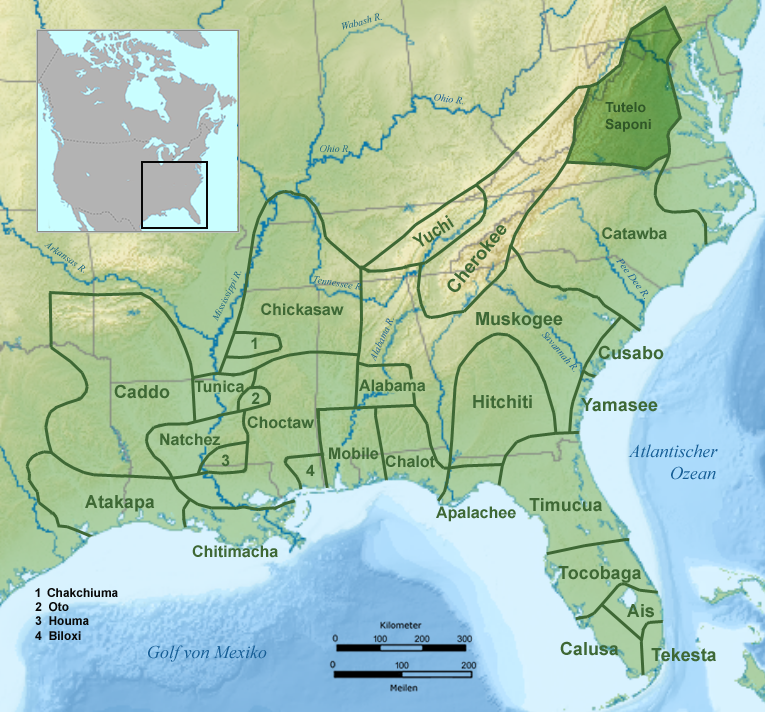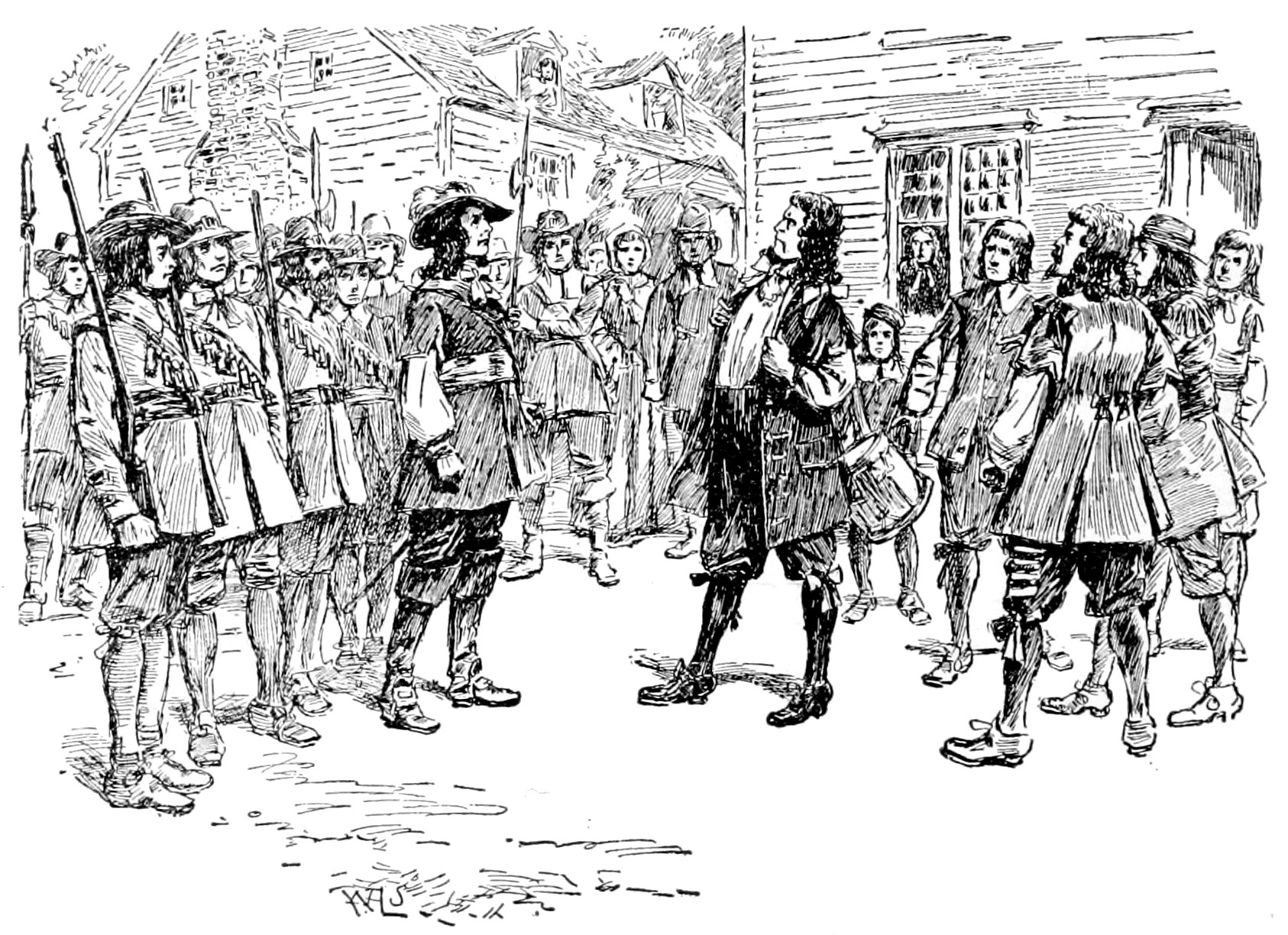|
Battle Of Bloody Run (1656)
The Battle of Bloody Run was fought in March or April of 1656 near Richmond, Virginia. In 1654, the expansion of the Iroquois Nation (during the Beaver Wars) displaced several tribes from their homelands around Lake Erie. One tribe moved south into Virginia, settling temporarily around the James River. Records of the time refer to these people as the "Richahecrians", while James Lederer said they were " Mahocks and Nahyssans". The colonists in nearby Richmond were uneasy with the proximity of a potentially hostile force. Within two years, the Virginia General Assembly had given permission to Colonel Edward Hill to remove the Indian presence. His orders specifically stated that he was not to use force unless necessary. The General Assembly also specifically sent messages to Chief Totopotomoi and the Chichahominy Indians, requesting their assistance. Colonel Hill led the Colonial Rangers, reinforced by 100 Pamunkey warriors under Chief Totopotomoi. When five "Richahecrian" c ... [...More Info...] [...Related Items...] OR: [Wikipedia] [Google] [Baidu] |
Colony Of Virginia
The Colony of Virginia, chartered in 1606 and settled in 1607, was the first enduring English colonial empire, English colony in North America, following failed attempts at settlement on Newfoundland (island), Newfoundland by Sir Humphrey GilbertGilbert (Saunders Family), Sir Humphrey" (history), ''Dictionary of Canadian Biography'' Online, University of Toronto, May 2, 2005 in 1583 and the colony of Roanoke (further south, in modern eastern North Carolina) by Sir Walter Raleigh in the late 1580s. The founder of the new colony was the Virginia Company, with the first two settlements in Jamestown, Virginia, Jamestown on the north bank of the James River and Popham Colony on the Kennebec River in modern-day Maine, both in 1607. The Popham colony quickly failed due to Starving Time, a famine, disease, and conflicts with local Native American tribes in the first two years. Jamestown occupied land belonging to the Powhatan Confederacy, and was also at the brink of failure before the arr ... [...More Info...] [...Related Items...] OR: [Wikipedia] [Google] [Baidu] |
Totopotomoi
Totopotomoi (c. 1615–1656) was a Native American leader from what is now Virginia. He served as the chief of Pamunkey and as ''werowance'' of the Powhatan Paramount Chiefdom for the term lasting from about 1649-1656, when he died in the Battle of Bloody Run. Name ''Totopotomoi'' is also spelled ''Totopotomoy'' and pronounced "To-to-POT-omy." English colonists of his time often spelled his name ''Totopotomy''. Totopotomy Creek in Hanover and Stafford counties memorializes his name. Personal life Totopotomoi was possibly the son but more likely the younger brother of the Necotowance. His exact parentage and date of birth are not known. Many assume he is the son of Necotowance because he succeeded him as chief. However, the Pamunkey and other tribes of Tidewater, Virginia were matrilineal societies. The right to become chief was passed down through the mother, not the father, and often from one brother to another, sons of the same mother. This is why Totopotomoi is believed t ... [...More Info...] [...Related Items...] OR: [Wikipedia] [Google] [Baidu] |
Richmond, Virginia
(Thus do we reach the stars) , image_map = , mapsize = 250 px , map_caption = Location within Virginia , pushpin_map = Virginia#USA , pushpin_label = Richmond , pushpin_map_caption = Location within Virginia##Location within the contiguous United States , pushpin_relief = yes , coordinates = , subdivision_type = Country , subdivision_name = , subdivision_type1 = U.S. state, State , subdivision_name1 = , established_date = 1742 , , named_for = Richmond, London, Richmond, United Kingdom , government_type = , leader_title = List of mayors of Richmond, Virginia, Mayor , leader_name = Levar Stoney (Democratic Party (United States), D) , total_type = City , area_magnitude = 1 E8 , area_total_sq_mi = 62.57 , area_land_sq_mi = 59.92 , area_ ... [...More Info...] [...Related Items...] OR: [Wikipedia] [Google] [Baidu] |
Beaver Wars
The Beaver Wars ( moh, Tsianì kayonkwere), also known as the Iroquois Wars or the French and Iroquois Wars (french: Guerres franco-iroquoises) were a series of conflicts fought intermittently during the 17th century in North America throughout the Saint Lawrence River valley in Canada and the lower Great Lakes region which pitted the Iroquois against the Hurons, northern Algonquians and their French allies. As a result of this conflict, the Iroquois destroyed several confederacies and tribes through warfare: the Hurons or Wendat, Erie, Neutral, Wenro, Tionontate, Susquehannock, Mahican and northern Algonquins whom they defeated and dispersed, some fleeing to neighboring peoples and others assimilated, routed, or killed. The Iroquois sought to expand their territory and to monopolize the fur trade with European markets. They originally were a confederacy of the Mohawk, Oneida, Onondaga, Cayuga, and Seneca tribes inhabiting the lands in what is now Upstate New York along the sh ... [...More Info...] [...Related Items...] OR: [Wikipedia] [Google] [Baidu] |
Lake Erie
Lake Erie ( "eerie") is the fourth largest lake by surface area of the five Great Lakes in North America and the eleventh-largest globally. It is the southernmost, shallowest, and smallest by volume of the Great Lakes and therefore also has the shortest average water residence time. At its deepest point Lake Erie is deep. Situated on the International Boundary between Canada and the United States, Lake Erie's northern shore is the Canadian province of Ontario, specifically the Ontario Peninsula, with the U.S. states of Michigan, Ohio, Pennsylvania, and New York on its western, southern, and eastern shores. These jurisdictions divide the surface area of the lake with water boundaries. The largest city on the lake is Cleveland, anchoring the third largest U.S. metro area in the Great Lakes region, after Greater Chicago and Metro Detroit. Other major cities along the lake shore include Buffalo, New York; Erie, Pennsylvania; and Toledo, Ohio. Situated below Lake Huron, Erie's p ... [...More Info...] [...Related Items...] OR: [Wikipedia] [Google] [Baidu] |
James River
The James River is a river in the U.S. state of Virginia that begins in the Appalachian Mountains and flows U.S. Geological Survey. National Hydrography Dataset high-resolution flowline dataThe National Map , accessed April 1, 2011 to Chesapeake Bay. The river length extends to if one includes the Jackson River, the longer of its two source tributaries. It is the longest river in Virginia. Jamestown and Williamsburg, Virginia's first colonial capitals, and Richmond, Virginia's current capital, lie on the James River. History The Native Americans who populated the area east of the Fall Line in the late 16th and early 17th centuries called the James River the Powhatan River, named for the chief of the Powhatan Confederacy which extended over most of the Tidewater region of Virginia. The Jamestown colonists who arrived in 1607 named it "James" after King James I of England (), as they constructed the first permanent English settlement in the Americas at Jamestown along t ... [...More Info...] [...Related Items...] OR: [Wikipedia] [Google] [Baidu] |
Manahoac
The Manahoac, also recorded as Mahock, were a small group of Siouan-language Native Americans (Indigenous people) in northern Virginia at the time of European contact. They numbered approximately 1,000 and lived primarily along the Rappahannock River west of modern Fredericksburg and the Fall Line, and east of the Blue Ridge Mountains. They united with the Monacan, the Occaneechi, the Saponi and the Tutelo. They disappeared from the historical record after 1728. Etymology According to William W. Tooker, the name ''Manahoac'' is Algonquian for "they are very merry", but anthropologist John R. Swanton considers this dubious. History After thousands of years of different indigenous cultures in present-day Virginia, the Manahoac and other Piedmont tribes developed from the prehistoric Woodland cultures. Historically the Siouan tribes occupied more of the Piedmont area, and the Algonquian-speaking tribes inhabited the lowlands and Tidewater. In 1608 the English explorer John Sm ... [...More Info...] [...Related Items...] OR: [Wikipedia] [Google] [Baidu] |
Tutelo
The Tutelo (also Totero, Totteroy, Tutera; Yesan in Tutelo) were Native Americans in the United States, Native American people living above the Atlantic Seaboard fall line, Fall Line in present-day Virginia and West Virginia. They spoke a Siouan dialect of the Tutelo language thought to be similar to that of their neighbors, the Monacan (tribe), Monacan and Manahoac nations. Under pressure from English settlers and Seneca people, Seneca Iroquois, they joined with other Virginia Siouan tribes in the late 17th century and became collectively known as the Nahyssan. By 1740, they had largely left Virginia and migrated north to seek protection from their former Iroquois opponents. They were adopted by the Cayuga people, Cayuga tribe of New York (state), New York in 1753. Ultimately, their descendants migrated into Canada. Name The English name ''Tutelo'' comes from the Algonquian variant of the name that the Iroquois used for all the Virginia Siouan tribes: Toderochrone(many variant s ... [...More Info...] [...Related Items...] OR: [Wikipedia] [Google] [Baidu] |
Virginia General Assembly
The Virginia General Assembly is the legislative body of the Commonwealth of Virginia, the oldest continuous law-making body in the Western Hemisphere, the first elected legislative assembly in the New World, and was established on July 30, 1619. The General Assembly is a bicameral body consisting of a lower house, the Virginia House of Delegates, with 100 members, and an upper house, the Senate of Virginia, with 40 members. Combined, the General Assembly consists of 140 elected representatives from an equal number of constituent districts across the commonwealth. The House of Delegates is presided over by the Speaker of the House, while the Senate is presided over by the Lieutenant Governor of Virginia. The House and Senate each elect a clerk and sergeant-at-arms. The Senate of Virginia's clerk is known as the "Clerk of the Senate" (instead of as the "Secretary of the Senate", the title used by the U.S. Senate). Following the 2019 election, the Democratic Party held a ma ... [...More Info...] [...Related Items...] OR: [Wikipedia] [Google] [Baidu] |
Bacon’s Rebellion
Bacon's Rebellion was an armed rebellion held by Virginia settlers that took place from 1676 to 1677. It was led by Nathaniel Bacon against Colonial Governor William Berkeley, after Berkeley refused Bacon's request to drive Native Americans out of Virginia. Thousands of Virginians from all classes (including those in indentured servitude) and races rose up in arms against Berkeley, chasing him from Jamestown and ultimately torching the settlement. The rebellion was first suppressed by a few armed merchant ships from London whose captains sided with Berkeley and the loyalists. Government forces arrived soon after and spent several years defeating pockets of resistance and reforming the colonial government to be once more under direct Crown control. Bacon's rebellion was the first rebellion in the North American colonies in which discontented frontiersmen took part (a somewhat similar uprising in Maryland involving John Coode and Josias Fendall took place shortly afterwa ... [...More Info...] [...Related Items...] OR: [Wikipedia] [Google] [Baidu] |
Nathaniel Bacon (colonist)
Nathaniel Bacon (January 2, 1647October 26, 1676) was a colonist of the Virginia Colony, famous as the instigator of Bacon's Rebellion of 1676, which collapsed when Bacon died from dysentery. Early life and education Bacon was born on January 2, 1647, in Friston Hall in Suffolk, England, to influential landowner parents Thomas Bacon and his wife Elizabeth (daughter of Sir Robert Brooke of Cockfield Hall, Yoxford and his wife Elizabeth). Nathaniel was his father's only son, and had one full sister, and a half-sister by his father's second wife Martha (Reade), his natural mother having died in 1649 when he was two years old. He was educated at the University of Cambridge, where he was admitted as a Fellow-Commoner at St Catharine's College in 1661. He travelled around Europe (Germany, Italy, Switzerland, France, Netherlands) in 1663–1664 with the celebrated naturalist John Ray and fellow pupils Francis Willughby and Philip Skippon. At the end of April 1664, in Naples, R ... [...More Info...] [...Related Items...] OR: [Wikipedia] [Google] [Baidu] |






